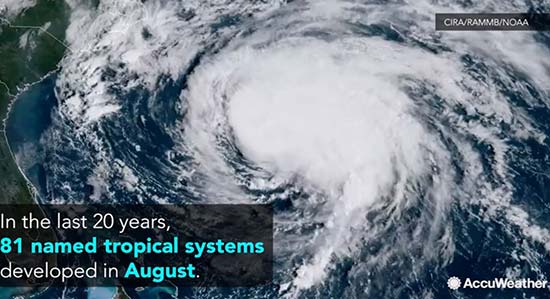Risk of flooding downpours to return to northeastern US this weekend, early next week

Drenching showers and thunderstorms will bring the risk of flash flooding to the central Appalachians and part of the mid-Atlantic, while the heaviest rain may focus on part of New England into early next week.
Have the umbrellas and raincoats handy again. There is the potential for the wettest swath in the Northeast to receive 5 inches of rain with locally higher amounts before the pattern breaks up.
Whether 5 inches of rain falls in as many days or an inch of rain falls in an hour, enough rain is expected to fall to lead to rising streams and possible urban and small stream flooding.

Repeating storms wasted no time in hammering parts of Ohio and southwestern Pennsylvania. As of 3 p.m. EDT Friday, more than 3 inches of rain fell on some of the suburbs of Pittsburgh in several hours.
"The greatest risk of flash flooding will be during, but not limited to, the daytime and early evening hours,"according to AccuWeather Lead Long-Range Meteorologist Paul Pastelok.
The rain may lead to delays and cancellations of some sporting events and could make moving into a new home, apartment or dorm a difficult one.
This swath of heaviest rain is likely to extend from parts of Pennsylvania and New Jersey to southeastern New York state, including much of the Hudson Valley and central and southwestern New England.
A second pocket of heavy rainfall may extend from southeastern Virginia to the coastal areas of the Carolinas by early next week.

The setup is likely to have more success at bringing downpours to the mid-Atlantic and southern New England beaches, when compared to July. So people heading to the beach for a last summer getaway before school starts may have to dodge some showers.
Areas most likely to escape the most persistent rainfall are from central and northern Maine to northern New York state and Michigan as well as portions of southern West Virginia, southwestern Virginia and the western portions of the Carolinas.
However, most locations in the Northeast outside of the most persistent rainfall will still run the risk of a downpour that could lead to isolated urban flooding.
A number of locations experienced their wettest July on record in the mid-Atlantic states including Harrisburg, State College and Williamsport, Pennsylvania; Baltimore and Washington, D.C.

Flooding forced evacuations and closed amusement parks in the region during the peak of the summer season.
Both Hartford, Connecticut, and New York City have received close to 10 inches of rain since early July. This rainfall is 150 to 200 percent of normal.
Meanwhile, portions of northern New York state and northern New England are experiencing moderate drought. In part of this area, rainfall since July 1 has been 50 percent of average.
What is causing the latest round of wet weather?
Just like the rainy patterns experienced in July and early August, the weather pattern set to produce the wet weather will not be correlated with a tropical storm.
A non-tropical storm is forecast to form and stall over the central Appalachians this weekend into early next week.
Even though the center of this storm will be located near the jet stream level of the atmosphere, the circulation around this storm will be able to pump a substantial amount of moisture in from the Atlantic Ocean and the Gulf of Mexico, Pastelok stated.
"We don't expect the troublesome upper-level storm to move out until later Tuesday or Wednesday,"Pastelok said.
More wet weather may be in the offing later in August
A break in the frequent downpours is likely for the middle part of next week, but another storm in the upper atmosphere may move in and move slowly through the region with more showers and thunderstorms by next weekend.
Since the pattern is looking more likely to remain wet through August, there may be a heightened concern for significant flooding as the hurricane season peaks during September and early October.
It would not take a powerful hurricane to cause major river flooding, but a mere slow-moving tropical storm tracking through the region could be enough.

